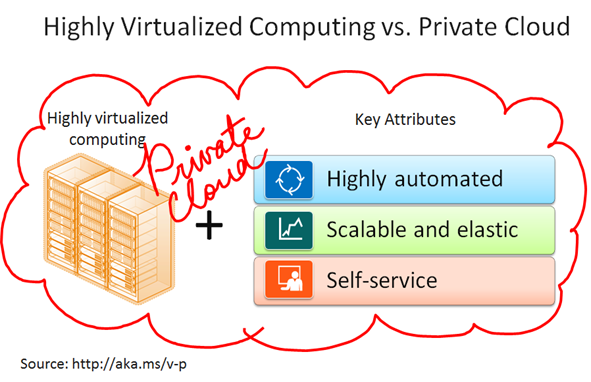Highly Virtualized Computing vs. Private Cloud (Reprised, 2/2)
Virtualization vs. private cloud has confused many IT pros. Are they the same? Or different? In what way and how? We have already virtualized most of my computing resources, is a private cloud still relevant to us? These are questions I have been frequently asked. This is the 2nd article of the series, as shown below, which answers these specific questions.
- Part 1: General concept
- Part 2: Private cloud specifics
Be Mindful on What Is Private Cloud
Above all, a private cloud is a deployment model of cloud computing. And since it is cloud computing, the 5-3-2 Principle or NIST SP-800-145 as preferred, applies. When one claims having a private cloud, we can easily verified if it actually is by a few simple questions. Is it delivered with (or at least a flavor of) SaaS, PaaS, or IaaS? Does it has a self-servicing component? Is there resource pooling and is it elastic? Namely standardization, optimization, and automation of resource management are implemented in the underlying infrastructure, such that a fabric-like abstraction can be formed with resource pools to possibly offer location transparency. Which is a private cloud or a cloud application in general must exhibit.
Is it delivered with (or at least a flavor of) SaaS, PaaS, or IaaS? Does it has a self-servicing component? Is there resource pooling and is it elastic? Namely standardization, optimization, and automation of resource management are implemented in the underlying infrastructure, such that a fabric-like abstraction can be formed with resource pools to possibly offer location transparency. Which is a private cloud or a cloud application in general must exhibit.
Notice that the hardware ownership is not a criterion. For a private cloud, hardware ownership is not a necessary, but a sufficient condition. One does not need to own the hardware to have a private cloud. Nonetheless, many seems to implicitly assume hardware ownership is part of a private cloud. This is likely due to for enterprise IT to transition into a private cloud environment, the logical approach is to, as applicable, assess and convert what has been established into a private cloud. In such case, likely the infrastructure is already owned and operated by the IT department.
Be Clear on What Private Cloud Delivers
A private cloud is a cloud with the cloud infrastructure dedicated to an organization. On premises or hosted by a 3rd party, a private cloud is expected to exhibit three, if not more, of the five essential characteristics of cloud computing: resource pooling, rapid elasticity, and self-service to differentiate itself from highly virtualized computing. The point is as far as virtualization is concerned, the three key attributes: resource pooling, elasticity, and self-service are not necessary conditions. While for a private cloud, the three are. Reviewing the 5 characteristics which cloud computing delivers, you will notice that I do not include ubiquitous access and consumption-based chargeback model as the key attributes for a private cloud. These two are not considered as essential due to: for a private cloud, the owning organization may want to restrict the availability, instead of allowing ubiquitous access; and a chargeback model may not be administratively necessary or technically feasible, for example, to be implemented in an organization. The following depicts the concept:
Closing Thoughts
There is no question that virtualization is a key technology enabler in transforming to a cloud environment. Without having a technically-mature and economically-affordable virtualization solution in place, cloud computing will be more a concept than an implementation. Nonetheless, make no mistake about it. virtualization is not, and in fact far from, a private cloud. Without resource pooling, elasticity, and self-servicing mechanism to fundamentally design efficiency into cloud architecture and minimize the overhead, implementing a private cloud can quickly become cost-prohibitive and without a predictable ROI in the long run. With these the key attributes and a virtualization solution, a private cloud therefore forms.
[Back to part 1]
